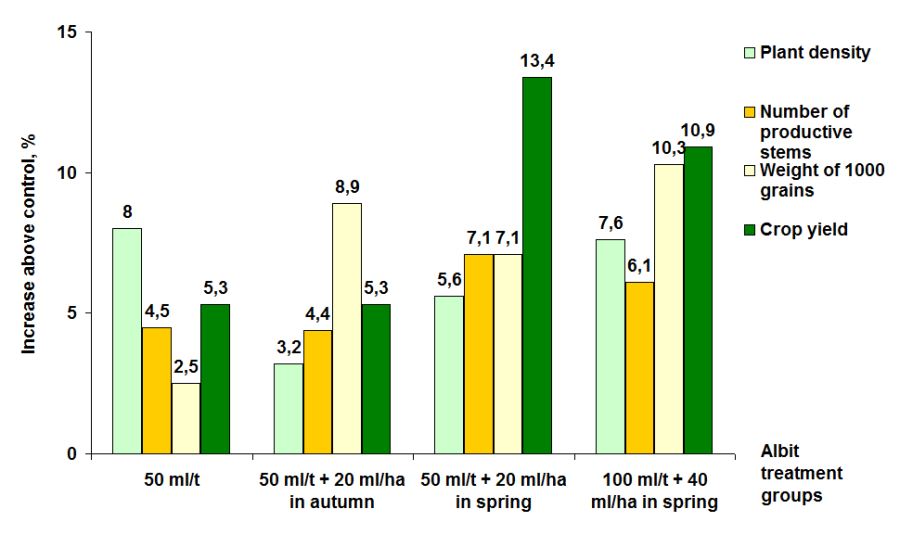|
|
Materials used in this chapter were published in the book Biostimulant Albit for increasing yields and protection of agricultures against diseases, A.K. Zlotnikov, Ed. Prof. À. Melkumova. All-Russia Institute of Plant Protection, Russia, 2006. Materials of this chapter are also published in: Zlotnikov A.K. Albit in the rye and triticale protection system / A.K. Zlotnikov, E.V. Kirsanova, A.A. Fadeev, Ò.À. Ryabchinskaya, V.Ò. Alyuhin, A.G. Medentsev // Zashchita i Karantin Rastenii (Plant Protection and Quarantine). – 2020. – ¹ 2. – pp. 14-17 (in Russian)
Only a few pesticides have proven their effectiveness on rye and have official registration. Albit is among them: it is registered on rye as a plant growth regulator (state registration number 081-07-866-1) with the application purposes, including to increase field germination, to activate growth processes, to increase resistance to unfavorable environmental conditions and disease, to increase yield, and to improve product quality. Albit is also used as an antidote to reduce the phytotoxic effect of pesticides. The effect of Albit on winter rye was tested in field trials in Voronezh, Oryol, Ryazan, Saratov, Penza, Arkhangelsk oblasts, and other regions. Trials were conducted since 1997 on the following rye varieties: Talovskaya 50, Talovskaya 33, Orlovskaya-9, Saratovskaya-5, Bereginya, and others. Albit has earned a good reputation in agricultural practices: for example, at Saratov oblast farms where Albit has been used since 1997. Based on the mean results of field trials, applying Albit increases the yield of winter rye by 320 kg/ha (22.3%). Albit was proven effective against Fusarium wilt and black helminthosporium. Above increasing yield and disease control, Albit boosts the rate of tillering, decreases spikelet sterility (empty spikelets), improves plant growth, and enhances color. Albit stimulates drought tolerance in rye, allowing to successfully cultivate this moisture-loving crop in the arid conditions of Saratov Oblast, Volgograd Oblast, and other southern regions. In the northern regions, Albit has a positive effect on rye growth and yield as well. In the Arkhangelsk region (the northern most border of the rye cultivation area), in 2019-2020 the use of Albit added 0.66 t/ha of yield (+ 13.4%) to 4.9 t/ha harvested in the control group. Interestingly, the control group's yield was considered high by the records of the region as is. Albit also improved the overwintering qualities of winter rye, increased plant density, and the number of spike-bearing stems (Fig. 1, 2). The best results were obtained in the group with pre-sowing seed treatment (50 ml/t) and spraying at the tillering stage (20 ml/ha) in spring.
Fig. 1. The effect of biostimulant Albit on growth and development of winter rye; varieties: Bereginya (The Federal Center for Integrated Arctic Research of the Russian Academy of Sciences (FCIARctic), Arkhangelsk Region, 2019) 1) Control; 2) Albit, 50 ml/t
Fig. 2. The effect of various methods and time of use of biostimulant Albit on yield variables and total crop yield of winter rye; varieties: Bereginya (The Federal Center for Integrated Arctic Research of the Russian Academy of Sciences (FCIARctic), Arkhangelsk Region, 2020)
The experiment also discovered the protective effect of Albit against major rye diseases: root rot, helminthosporium leaf spot, leaf rust (biological efficiency varying from 16.7 to 70.3%). Application recommendations.To achieve the product's maximal beneficial effect, we recommend conducting a pre-sowing seed treatment and a one-time treatment during the growing period at the tillering stage (20-30 BBCH). Growing period treatments (foliar spraying) are proven to be more efficient if conducted in spring. We advise to apply Albit together with fungicide seed treatment (reduced or full rate) when treating seeds and with herbicides, liquid fertilizers, or insecticides when treating crops. In the presence of bunt or other internal infections, seed treatment with Albit is must be combined with a chemical fungicide treatment. Recommended application rates of Albit are 50 ml/t for pre-sowing seed treatment and 20 ml/ha for foliar spraying. For all available reports, please see corresponding table on the Russian webpage
|
|
||||||||||||||||||||||||||||||||||
Terms and Conditions
|
|


 Rye is a high-potential grain crop that is becoming increasingly important in the agriculture of Russia and other countries. Not only is rye a traditional cereal grain, but also it is one of the most widespread and most valuable green manure crops after mustard. Unlike wheat, rye has 1.5 times more vigorously developed root system, which is why rye does not depend on the soil quality as much as wheat does. Rye crops are resistant to frost and severe droughts. Winter rye is flexible when it comes to the distribution area: it is the most adaptable crop for regions with difficult natural and climatic conditions. Only rye can tolerate the lowest possible temperature of –23 °Ñ at the tillering node level. Russia ranks third in the world in rye production after Germany and Poland. In 2019, this crop was grown on 872 thousand hectares in our country.
Rye is a high-potential grain crop that is becoming increasingly important in the agriculture of Russia and other countries. Not only is rye a traditional cereal grain, but also it is one of the most widespread and most valuable green manure crops after mustard. Unlike wheat, rye has 1.5 times more vigorously developed root system, which is why rye does not depend on the soil quality as much as wheat does. Rye crops are resistant to frost and severe droughts. Winter rye is flexible when it comes to the distribution area: it is the most adaptable crop for regions with difficult natural and climatic conditions. Only rye can tolerate the lowest possible temperature of –23 °Ñ at the tillering node level. Russia ranks third in the world in rye production after Germany and Poland. In 2019, this crop was grown on 872 thousand hectares in our country.


